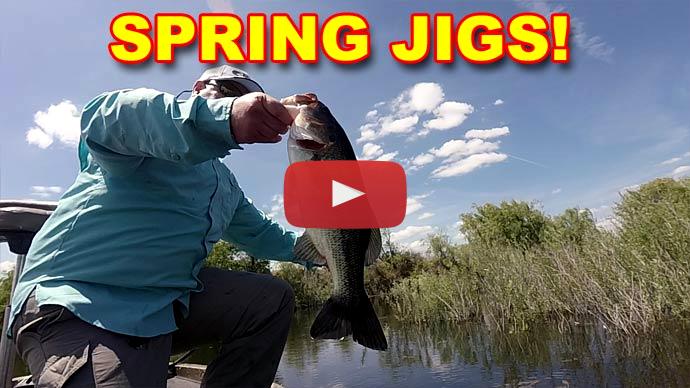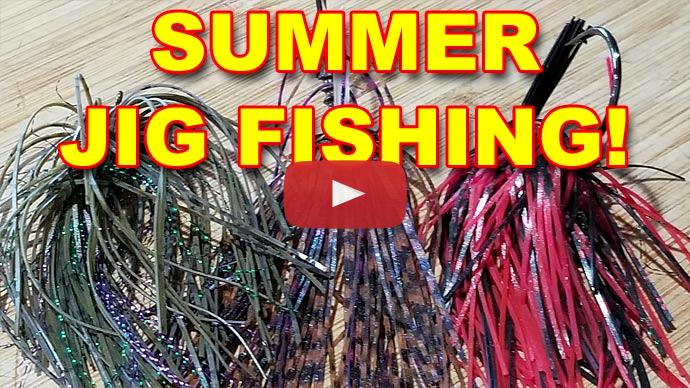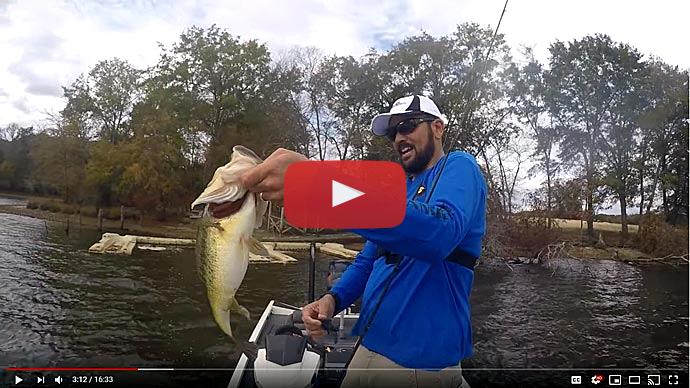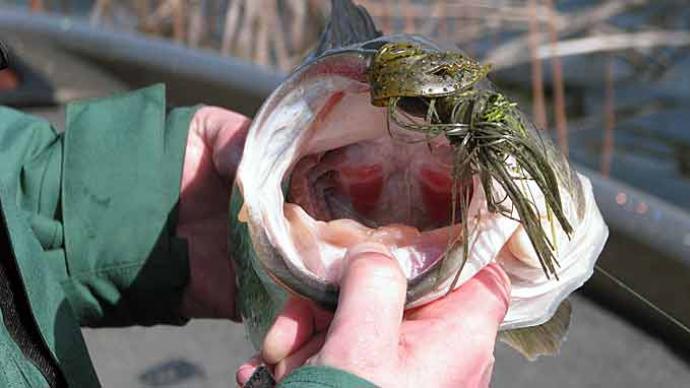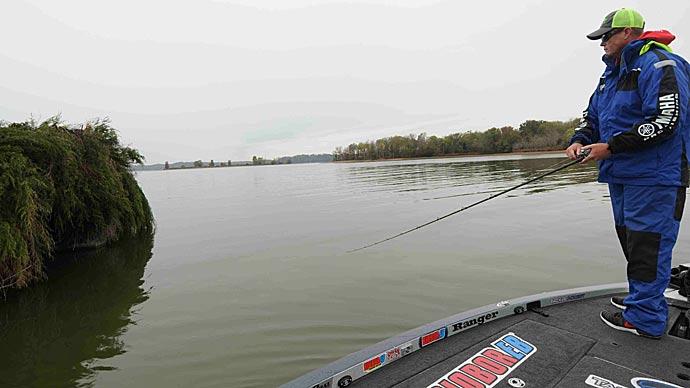Glenn: There we go.
Keri: Oh, hello. You got him.
Oh, boy. He is wrapped around a tree.
Keri: You gotta go in and get him.
Glenn: Come here.
Keri: You're gonna have to go in and get him.
Glenn: Come here. Come here.
Keri: And let him back in the water.
Glenn: Let's see if I can get this guy out, see if this Seaguar braid is gonna hold on to him good enough. He is wrapped around this stuff.
Keri: He did, he jumped out of the water and went right around that branch.
Glenn: Come here. Come here. I got your face. Look at that. Yeah, we're throwing in the thick stuff with some jigs. So we're talking about today, how to jig fish in heavy stuff like this.
Hey, folks, Glenn here with BassResource.com. And today, I wanna talk to you about fishing jigs. Jigs, day in and day out, year round, will catch fish. And a lot of times, we'll catch big ones. They're just known for big fish type lures. They're not gonna catch a lot of numbers. But a lot of times, when you hook in to a fish with a jig, it's a quality bass.
So today, I wanna talk to you a little bit about this. If you've been fishing jigs for a while, you're gonna get a few tips here from this video. But if you're new to it, you haven't fish jigs a whole lot, listen up, because this video is definitely for you. We're gonna talk a little bit about the right equipment to use for jigs, a little bit about the jigs themselves, what you wanna look for when you're buying them. And then we're gonna talk to you about some of the different retrieves you can use with jigs.
So let's talk about equipment, starting with the rod. A good all-around purpose rod for jig fishing is a seven-foot heavy power, medium or fast action rod tip. This here is an Okuma TCS Jig and Worm Rod, perfect for the situation. It's not a flipping stick. Now flipping, you can also do that with jigs, you wanna get a flipping stick for that, those are typically a little bit longer, maybe seven-five to even close to eight feet long, with the same characteristics. Again, heavy power, fast action rod tip. That's what you wanna look for for jigs because you're gonna be throwing this on a lot of heavy cover. You have to use a rod that's got a lot of backbone, a lot of power that'll turn that fish and get him out of that cover before he has a chance to turn and wrap around everything and break free. So that's why you need that strong, strong heavy rod for that.
Paired with to this line, I'm using 50-pound Seaguar Smackdown Braid. This is a good, universal braided line that works really, really well in all conditions, especially when you're throwing in trees and shrubs, and all the heavy thick stuff where you're gonna be throwing jigs. I use 50-pound minimum, sometimes I'll use 65-pound. You can also use Seaguar's Flippin’ line, which I've been using for a while now. It's excellent, excellent line. Your choice, both are really good to use. The Flippin’ line I tend to use when the water is really muddy and dingy, it's perfect for those situations The Smackdown is much better for when the water is a little bit clear.
The reel, you can use just about any reel. This is an Okuma Helios reel. This has a really strong drag system. That's what you want. When you set the hook, you've got to have this drag cranked down all the way tight. When you first set the hook, you can't have any give at all. Set that hook home. Once you get the fish clear out of the cover, then you can loosen on the drag and fight him back to the boat. But you've to get a solid hookset first so a strong drag is imperative. This reel has a 7.3:1 gear ratio. I like that because, again, it gives me that speed to get that fish out of the cover quickly. So a high speed reel with a strong drag, that's the main characteristics you want for jig fishing.
So let's talk a little bit about the jigs themselves. If you're first starting out, you don't need to buy a ton of different jigs out there. Really focus with two different colors, your browns and your green pumpkins. This one is brown, as you can see. This is a Siebert’s jig, this is a brush jig. You want browns color. Browns and greens are gonna cover most of your jig fishing situations. Yeah, there's, black and blue works really well if you're fishing in water, say the visibility is less than a foot and a half, less than a foot, really muddy, and you’re fishing real dense cover, then black and blue work really well to show up as a silhouette in that muddy water. I don't get that much of that up here. You know, we live up here in the Pacific Northwest. Not too often, we encounter real muddy conditions, so this is my go-to is the browns and also the green pumpkins.
There's a couple of things you wanna look for when you're getting a jig. First of all is a real strong, stout hook. We're using heavy, heavy gear, again, strong braid, strong rod, so you need a hook that's gonna hold up to that. So let's look at this hook, man. That's a beefy hook on this. Again, Siebert jigs, they make excellent, excellent jigs. And that's what you want, a strong stout hook, to put up with the pressure when you set the hook.
The other thing here too, as you notice, on this one, jig heads basically come in essentially two different varieties. One is a football head jig, the other one is what I call cone shape. There's a lot of variations out, a lot of different names. And they're more specialized specific purposes like Arkey jigs, things like that. But it all boils down to whether it's a pointed jig or a football jig. And on the pointed jigs, if you will, in this particular case, this is the Siebert brush hawg. Look at this, the line tie is part of the jig head. Isn't that cool? And then stick out. And that's important, because as less things that gets hung up in the weeds, you know, you're not gonna bring back a lot of junk and stuff and when you're fishing all those heavy cover. So that's important.
Here's the thing, up until about all five or so years ago with jigs, it used to come out of packets pretty much the same where the strands are really long, you'd have to cut them off, because you want the strands to be just past the hook point. If you notice, look at that, that's exactly where these are. The strands had just passed the hook point. So what we do is we cut those off because it would come really long. Well, nowadays, you don't have to do that. Most jigs come with the right length. Same thing with the brushguard on, the weed guard. You see, when you press down on it, it just covers that point just right, okay? There's not a whole lot of excess sticking and past it.
What I like to do as far as any type of changing anything or modifying any of the jigs, when they first come out of the package, really all as it is, is I sharpen the hooks, I always do that, it's just a habit, but I wanna make sure they're super, super sharp. And the other thing is I always add a trailer on to it. In this case, this is a Rage Tail, Rage Craw and it matches the colors pretty good. It matches the colors of the skirt really well. And all that I do on this is I typically pinch off just about an eighth of an inch or a quarter of an inch on the end of it. So when I rig it on to the bait, also I want is, I want those claws just hanging pass the hook. I don't want to hang too far pass beyond that. So it makes a nice compact, bite-size lure.
By the way, I wanna tell you, when you're buying jigs, you don’t have to buy all kinds of different weights. Get a quarter ounce, half ounce and three-quarter-ounce, that's gonna cover most of your jig situations. I'm not talking about punching, so don't write me hate mail. Punching's a different technique, altogether. But that's gonna cover most of your situations. That's really all there is to it.
All right. So we've talked about the equipment, we've talked about the jigs. Now, let's talk about the different ways to fish it.
The easiest and most common way of fishing a jig is you just throw it out there and you let it sink straight down on a semi-slack line. And you'll notice I did a bunch of things right there all at one. So I'll take you through it step-by-step.
When you throw it in there, you bring the rod tip down, and you reel up the slack line, and then you wanna feel that bait a semi-slack line. In other words, you can still letting it fall straight down, but you don't have a super slack line, and you're actually feeling some contact of the line between your bait and the rod. So watch this. You throw it out there, bring the rod tip down to hook set position, reel in the slack, and now, we've got connection with it. It's that quick. It happens very, very fast. So I'll show you one more time so you can... This is the motion you've got to do all the time. As soon as that bait hits the water, you gotta be in the hook set position. So cast it out there, let it hit, bring the rod tip down, reel up the slack, I'm ready to go, okay? You don't wanna bring up too much slack because you don't want the bait to swing away from the cover. You want it to fall straight down. But that's the key.
Okay, so when it's falling, what you wanna do is make a mental note for how long it's gonna take before it hits the bottom. If you have to, do a count. Some sort of like one, two, three, some sort of cadence to get into sense of how long it takes to fall and hit the bottom. So, for example, we'll do it here. I'll cast this out here real quick. We hit the bottom, okay. So it's one, two, three, four, five. Okay, five and a half is about what it took. So say now, I'm going along the… This is the shoreline, and it's hitting around your four, five every time, maybe six. And then I could cast and it stops at one. Well a fish probably hit it, okay?
Set the hook, definitely set the hook. And you wouldn't have known that, because a lot of times, you don't feel it. The fish is just sitting there, he opens his mouth, he grabs it and they doesn't move, so you won't feel a bite. You'll just notice that the jig didn't fall all the way like it should have. So be very, very much on point watching for things like that, when it does that, watch for your line, see if it twitches, jumps, moves sideways. If it does anything that you didn't do, a fish probably did. So set that hook, okay?
And speaking of setting the hook, let me walk you through something real quick. I've seen a lot of jig fishermen do this. When you set the hook, what they'll do is they'll let that bait fall and they think they got a bite, they'll reel down, they’re on point, and they do this feel game. They pull back a little bit more. Okay, now they feel a tug-tug, definitely a fish, and they set the hook.
Problem with that is you set the hook on a tight line. Lot of times, what happens is that that bait is barely in the fish's mouth, maybe just a little bit. And all that you did when you set the hook is you move the bait maybe that much in his mouth, or the head of this is resting on the inside of his mouth. And so all that you did is you just turned that fish. You didn't get a hook. If anything, the hook didn't get in very far. And you reeling up towards him and all of a sudden, he opens his mouth and blows that bait right out.
This is especially true if you're fishing football head jigs. Football head jigs have a real tendency to do it, they're big, they're bulky, they'll hit up on the inside the roof of the fish's mouth, and the hook never penetrates, and then that fish blows it right out.
So instead, when you're making the hook set, what you wanna do is you reel it down. I'll just cast it out then do this. You wanna have a little slack in it. So first of all, you're in the hook set position, ready to go. If you lift up and you feel a bite, drop the rod tip quick, reel in maybe one or two turns, but you still have slack in it, and then set the hook really hard, okay?
You wanna throw slack in it, that's the key. You wanna jar that bait, not turn the fish's head. You wanna get the power of the rod going, get the speed of that rod going before it makes contact with the bait. Now, you're going full-fledged, full power. The bait, boom, slams into the fish's mouth, and oftentimes, so hard that it will go through his lips. But he still has his mouth closed and that hook comes right behind and hooks them. You almost always hook them in the roof of the mouth when they do that, and you got a solid, solid hooks that he's not coming unbuttoned, okay?
So that's the key, is that hook set. Make sure you've throw a little bit of slack in the line. If you have to, if you feel that fish and you're playing the feel game, just drop the rod and then set the hook something. But you've got to practice that and get that down because throwing slack in the line is key to get in a really solid hook set.
All right, so let me talk you through some of the different techniques here. One was throwing it out there, and you just let it drop. A lot of times a fish hit it during the fall. So that's why I said, you got to be ready for the hook set. But if it hits the bottom with jigs, let it sit for a second. What jigs will do, especially with living rubber skirts, they'll sit on the bottom, they'll start to slowly open up like this. Even if it's not living rubber, they'll still move a little bit. A lot of times, a fish will come up, they'll look at it, they'll nose down to it, and then it's just making that little bit of movement, and they just can't stand it, then you gotta pounce on it.
Okay, so let the jig do its thing. I know it's boring, you're not doing anything, you're just sitting there. But just hold on a minute, just keep contact with that bait. The next thing you know, you'll see your line start swimming off. You won't even feel the bite. So do that first.
Now, if that fish doesn't bite, now what I want you to do is… You know again, a lot of the bites occur during the fall, so you've got to make it fall again. So now it's sitting on the bottom, you're gonna sit for quite a while, then all you're gonna do is you get your… You're pointing down towards the lure, lift up a little bit, get your rod to about the 10:00, 11:00 position, let it drop. And here, I mean it dropped straight down. And all I'm doing is I'm reeling up the slack as I bring the rod tip down. So I'm still maintaining contact with the bait, but I'm not altering its trajectory.
And then that's all you do, is you just bring it up and bring it back down. You do a couple of times, and it'll probably be back to the boat by then, but you don't have to work it all the way back to the boat. Once you've pulled, got free of cover, the fish probably isn't gonna bite on that type of retrieve. So you bring it back up, let it fall back down, just reel at the slack as it falls, let it hit bottom, and let it sit again, let it open up, do its thing. Again, five, 10 seconds, it doesn't take very long, and then lift it back up again, and repeat, okay?
Now, if those two techniques aren't working and the fish don't wanna bite it on the fall, so you got to do something different. And one of the things I like to do is drag it on the bottom. You throw it out there, let it sit on the bottom. Once it’s on the bottom, you wanna let it scurrying on the bottom, just like a crawdad. I mean, that's what that jig is imitating, is a crawdad. So reel up all the way, and then what you wanna do is you move it just with your rod, not with your reel, and there's a couple of ways you can do this.
First is just to drag it straight back with your rod, and then reel up the slack, and you're ready to go. And then just drag it again, and reel up the slack. Again, you always wanna be on a hook set position. So you don't wanna be…have your rod all the way back here if a fish bites, try to set the hook even further. You have nothing left. There's nothing to give you any leverage. So if a fish hits it while you're dragging it back, just like I just told you before with the hook set, reel up to it, and then set the hook. Give yourself that advantage, so you can get a good hook set on that fish. But that's a really good technique, just drag it back like that.
Now, another way that I'll do, I'll do some variations. Because again, this is a crawdad imitation, so I like to make it scoot along the bottom. Almost like it's a crawdad trying to get away. If you ever watch a crawdad under water, they kind of move, move, move like this. Sometimes, it'll be just two-two or, you know, three little pumps, four. But they do this kind of thing. So that's what you wanna imitate. So you just kind of pop, pop, pop, pop, pop, and let it drop, and then pop, pop, pop, pop, and let it drop. Maybe let it sit for a while, let that skirt flare out, and then give another pop, pop, pop, and let it sit.
It looks like he's trying to get away from the fish. And especially if you throw this up in the cover and you let it drop, the fish doesn't bite it. Now, you can scoot it away from the cover, any fish that are in that cover looking at it, it looks like now it's trying to get away, they'll race up and smack it. It works a lot of times.
The last one I wanna show you is kind of a swim jig technique. But again, I'm not talking about swim jigs, but I do like to swim these back. This works especially well with a heavier jig head. And so with this next one, I like to deal with three-quarter-ounce jig heads because I wanna keep it down towards the bottom. You throw it out, let it hit the bottom. I wanna keep it just off the bottom. I just slowly reel it, just slowly swim it back. And what I wanna do is I wanna feel it hit the bottom every now and then. And I'll just speed up the reel just a little bit more, just to make sure that it stays just off the bottom.
But a lot of times, it seems kind of boring, right? It's slow reeling it, it's not quite dragging along the bottom. But boy, howdy, man, when the fish hit it, they will smack it. I mean, they will try to rip the rod out of your hand. So hold on tight, always be in the hook set position, so you want the rod up here, just slowly reel it back, and let it kind of bump all along, occasionally bumping on the bottom. And a lot of times, you'll catch fish that way.
All right. So those are some of the essential jig fishing information that you need to know about. I didn't go to all the different kinds of jigs, because I'm telling you what, I can go on and on. So we'll have some other videos on the more advanced techniques. But if you're just getting into jig fishing, everything I just told you, follow what I told you. And I'm telling you what, you'll become a better bass angler. For more tips and tricks like this, visit BassResource.com.

